Anemones Study guides, Class notes & Summaries
Looking for the best study guides, study notes and summaries about Anemones? On this page you'll find 78 study documents about Anemones.
Page 2 out of 78 results
Sort by
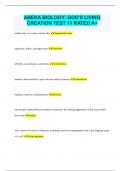
-
ABEKA BIOLOGY: GOD'S LIVING CREATION TEST 11 RATED A+
- Exam (elaborations) • 8 pages • 2024
- Available in package deal
-
- $9.99
- + learn more
ABEKA BIOLOGY: GOD'S LIVING CREATION TEST 11 RATED A+ earthworms, sea worms, and leeches segmented worms planarians, flukes, and tapeworms flatworms jellyfish, sea anemones, and hydras coelenterates animals characterized by spiny skin and radial symmetry echinoderms euglenas, amoebas, and paramecia protozoa microscopic multicellular invertebrates named for the rotating appearance of the cilia on their front ends rotifers what consists of stacks of flattened, membrane-encl...
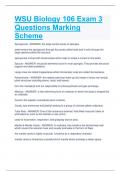
-
WSU Biology 106 Exam 3 Questions Marking Scheme
- Exam (elaborations) • 18 pages • 2023
- Available in package deal
-
- $13.99
- + learn more
WSU Biology 106 Exam 3 Questions Marking Scheme Spongocoel - ANSWER- the large central cavity of sponges. water enters the spongocoel through tiny pores called ostia and it exits through the large opening called the osculum. spongocoel is lined with choanocytes which help to create a current in the water. Spicule - ANSWER- structural elements found in most sponges. They provide structural support and deter predators. Large ones are called megascleres while microscopic ones are calle...
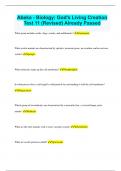
-
Abeka - Biology: God's Living Creation Test 11 (Revised) Already Passed
- Exam (elaborations) • 8 pages • 2024
- Available in package deal
-
- $9.99
- + learn more
Abeka - Biology: God's Living Creation Test 11 (Revised) Already Passed What group includes snails, slugs, conchs, and nudibrancks? Gastropods What sessile animals are characterized by spicules, incurrent pores, an osculum, and no nervous system? Sponges What molecules make up the cell membrane? Phospholipids In what process does a cell engulf a solid particle by surrounding it with the cell membrane? Phagocytosis Which group of invertebrates are characterized by a muscular fo...
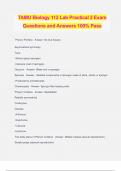
-
TAMU Biology 112 Lab Practical 2 Exam Questions and Answers 100% Pass
- Exam (elaborations) • 23 pages • 2024
- Available in package deal
-
- $12.49
- + learn more
TAMU Biology 112 Lab Practical 2 Exam Questions and Answers 100% Pass Phylum Porifera - Answer- No true tissues Asymmetrical symmetry Taxa: -Silicea (glass sponges) -Calcarea (rest of sponges) Osculum - Answer- Water exit in sponges Spicules - Answer- -Skeletal components of sponges made of silica, calcite or spongin -Produced by amoebocytes Choanocytes - Answer- Spong's filter-feeding cells Phylum Cnidaria - Answer- Diploblastic Radially symmetrical Cnidocytes Classes: -Anthozoa...
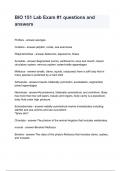
-
BIO 151 Lab Exam #1 questions and answers
- Exam (elaborations) • 5 pages • 2024
- Available in package deal
-
- $7.99
- + learn more
BIO 151 Lab Exam #1 questions and answers Porifera - answer-sponges Cnidaria - answer-jellyfish, corals, sea anemones Platyhelminthes - answer-flatworms, tapeworms, flukes Annelida - answer-Segmented worms, earthworms; anus and mouth; closed circulatory system; nervous system; setae-bristle appendages Mollusca - answer-(snails, clams, squids, octopuses) have a soft body that in many species is protected by a hard shell Arthopoda - answer-Insects: bilaterally symmetric; exoskeleton; segm...
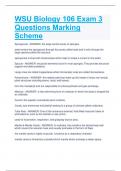
-
WSU Biology 106 Exam 3 Questions Marking Scheme
- Exam (elaborations) • 18 pages • 2023
-
Available in package deal
-
- $13.39
- + learn more
WSU Biology 106 Exam 3 Questions Marking Scheme Spongocoel - ANSWER- the large central cavity of sponges. water enters the spongocoel through tiny pores called ostia and it exits through the large opening called the osculum. spongocoel is lined with choanocytes which help to create a current in the water. Spicule - ANSWER- structural elements found in most sponges. They provide structural support and deter predators. Large ones are called megascleres while microscopic ones are ca...
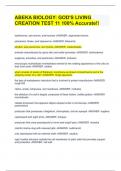
-
ABEKA BIOLOGY: GOD'S LIVING CREATION TEST 11 100% Accurate!!
- Exam (elaborations) • 4 pages • 2024
-
Available in package deal
-
- $9.99
- + learn more
earthworms, sea worms, and leeches -ANSWER segmented worms planarians, flukes, and tapeworms -ANSWER flatworms jellyfish, sea anemones, and hydras -ANSWER coelenterates animals characterized by spiny skin and radial symmetry -ANSWER echinoderms euglenas, amoebas, and paramecia -ANSWER protozoa microscopic multicellular invertebrates named for the rotating appearance of the cilia on their front ends -ANSWER rotifers what consists of stacks of flattened, membrane-enclosed c...
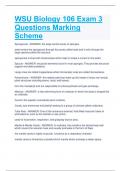
-
WSU Biology 106 Exam 3 Questions Marking Scheme
- Exam (elaborations) • 18 pages • 2023
- Available in package deal
-
- $13.99
- + learn more
WSU Biology 106 Exam 3 Questions Marking Scheme Spongocoel - ANSWER- the large central cavity of sponges. water enters the spongocoel through tiny pores called ostia and it exits through the large opening called the osculum. spongocoel is lined with choanocytes which help to create a current in the water. Spicule - ANSWER- structural elements found in most sponges. They provide structural support and deter predators. Large ones are called megascleres while microscopic ones are calle...
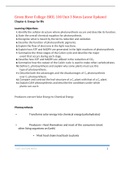
-
Green River College: BIOL 100 Unit 3 Notes Latest Updated,100% CORRECT
- Class notes • 116 pages • 2023
-
- $16.99
- 1x sold
- + learn more
Green River College: BIOL 100 Unit 3 Notes Latest Updated Chapter 6: Energy for life Learning Objectives: 1. Identify the cellular structure where photosynthesis occurs and describe its function. 2. State the overall chemical equation for photosynthesis. 3. Recognize what is meant by the terms reduction and oxidation. 4. Describe the function of photosynthetic pigments. 5. Explain the flow of electrons in the light reactions. 6. Explain how ATP and NADPH are generated in the light reac...
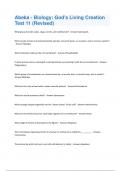
-
Abeka - Biology: God's Living Creation Test 11 (Revised) Questions and Answers 2024 Complete;100%
- Exam (elaborations) • 5 pages • 2024
- Available in package deal
-
- $7.99
- + learn more
What group includes snails, slugs, conchs, and nudibrancks? - Answer-Gastropods What sessile animals are characterized by spicules, incurrent pores, an osculum, and no nervous system? - Answer-Sponges What molecules make up the cell membrane? - Answer-Phospholipids In what process does a cell engulf a solid particle by surrounding it with the cell membrane? - AnswerPhagocytosis Which group of invertebrates are characterized by a muscular foot, a visceral hump, and a mantle? - Answer-Mollus...

Do you wonder why so many students wear nice clothes, have money to spare and enjoy tons of free time? Well, they sell on Stuvia! Imagine your study notes being downloaded a dozen times for $15 each. Every. Single. Day. Discover all about earning on Stuvia


